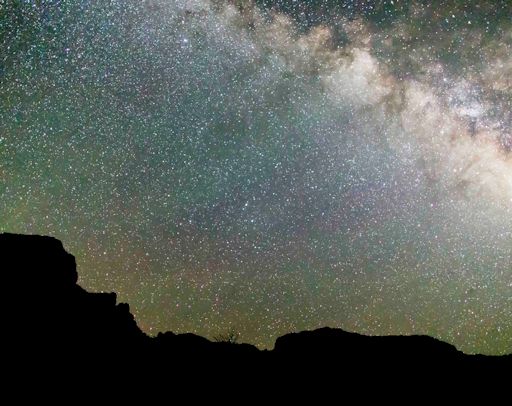CME PASSAGE: Magnetic fields in the solar wind intensified on July 13th, indicating the possible passage of a minor CME past Earth. The encounter did not immediately trigger geomagnetic storms. NOAA forecasters remain optimistic, however, placing the odds of a polar geomagnetic storm on July 14th at 65%. Aurora alerts: text, voice.
WEAK IMPACT, BRIGHT LIGHTS: A weak CME impact on July 9th gave sky watchers more than they bargained for. Although the blow was feeble, both ends of the Earth lit up with auroras that persisted for nearly two days. Minoru Yoneto photographed the display from Queenstown, New Zealand:
"I did not expect to see big, bright Southern Lights from such a weak CME impact," says Yoneto. "Yet they were definitely present on July 10th." Sky watchers in Canada and northern-tier US states from Michigan to Washington saw similar displays right up until sunrise on July 11th.
The CME was effective in sparking high-latitude auroras because its wake contained a south-pointing magnetic field--a.k.a. "negative Bz". This opened a crack in Earth's magnetosphere, allowing solar wind to pour in and fuel the Northern and Southern Lights.
The moral to this story: Even weak CMEs can trigger bright auroras if the CME is dragging behind it a south-pointing magnetic field. The next CME is due on JUly 13th. Stay tuned. Aurora alerts: text, voice.
GREEN SKIES OVER TEXAS: Not all colorful lights in the sky are the aurora borealis. Astrophotographer Kenneth Edwards discovered this for himself on July 4th when he was taking a long exposure of the Milky Way over Big Bend National Park, Texas:
"For the long 4th of July weekend I went with my daughter to Big Bend National Park to try some time lapse photography of the Milky Way," says Edwards. "After getting back home, I was creating a time lapse video when I noticed the green colors. They were not visible to the naked eye but it sure was clear in the pictures and videos."
The green light is called "airglow." Airglow is a luminous bubble that surounds our entire planet, fringing the top of the atmosphere with aurora-like color. Although airglow resembles the aurora borealis, its underlying physics is different. Airglow is caused by an assortment of chemical reactions in the upper atmosphere driven mainly by solar ultraviolet radiation; auroras, on the other hand, are ignited by gusts of solar wind.
Green airglow is best photographed from extremely dark sites on nights when the Moon is new or below the horizon. It often shows up in long exposures of the Milky Way: more airglow.

Solar wind
speed: 410.1 km/sec
density: 2.5 protons/cm3
explanation | more data
Updated: Today at 0236 UT
X-ray Solar Flares
6-hr max: B5 1844 UT Jul13
24-hr: C1 0544 UT Jul13
explanation | more data
Updated: Today at: 2359 UT
![]()
Daily Sun: 13 July 13
Decaying sunspot complex AR1785-87 poses a slim threat for M-class solar flares. Credit: SDO/HMI
![]()
Sunspot number: 87
What is the sunspot number?
Updated 13 Jul 2013
Spotless Days
Current Stretch: 0 days
2013 total: 0 days (0%)
2012 total: 0 days (0%)
2011 total: 2 days (<1%)
2010 total: 51 days (14%)
2009 total: 260 days (71%)
Since 2004: 821 days
Typical Solar Min: 486 days
Update 13 Jul 2013
The Radio Sun
10.7 cm flux: 118 sfu
explanation | more data
Updated 13 Jul 2013
![]()
Current Auroral Oval:
Switch to: Europe, USA, New Zealand, Antarctica
Credit: NOAA/POES
![]()
Planetary K-index
Now: Kp= 2 quiet
24-hr max: Kp= 3 quiet
explanation | more data
Interplanetary Mag. Field
Btotal: 10.9 nT
Bz: 6.6 nT south
explanation | more data
Updated: Today at 0237 UT
![]()
Coronal Holes: 13 Jul 13
A large coronal hole is emerging over the sun's NE limb. Credit: SDO/AIA.
![]()
Spaceweather.com is now posting daily satellite images of noctilucent clouds (NLCs), which hover over Earth's poles at the edge of space. The data come from NASA's AIM spacecraft. The north polar "daisy" pictured below is a composite of near-realtime images from AIM assembled by researchers at the University of Colorado's Laboratory for Atmospheric and Space Physics (LASP). |
![]() Noctilucent Clouds
Noctilucent Clouds
Switch view: Europe, USA, Asia, Polar
Updated at: 07-13-2013 13:55:02







